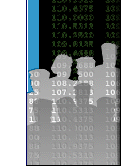IN THIS SECTION:
Regulators | Exchanges | Clearinghouses and Margins | Futures Commission Merchants | Introducing Brokers | Commodity Pools | Commodity Trading Advisors
Exchanges
 Futures and options on futures exchanges are associations of members organized to provide competitive markets and the facilities and staffs to support such markets. The first U.S. futures exchange was the Chicago Board of Trade, organized in the mid-nineteenth century to provide a central marketplace where buyers and sellers could meet under rules that protect the interest of all concerned. Since then, the number of futures exchanges throughout the world has rapidly increased to more than 90 and the not-for-profit membership model was not followed by new exchanges and many have demutualized to become a for-profit organization.
Futures and options on futures exchanges are associations of members organized to provide competitive markets and the facilities and staffs to support such markets. The first U.S. futures exchange was the Chicago Board of Trade, organized in the mid-nineteenth century to provide a central marketplace where buyers and sellers could meet under rules that protect the interest of all concerned. Since then, the number of futures exchanges throughout the world has rapidly increased to more than 90 and the not-for-profit membership model was not followed by new exchanges and many have demutualized to become a for-profit organization.
In the United States, exchange membership is available only to individuals, some of whom hold a membership for their firm. Members of an exchange may exercise their trading privileges as independent market-makers (so-called floor traders or locals) trading for their own accounts or as floor brokers executing customer orders. Exchange members who trade both for customers and for themselves are called dual traders.
Today, a sizeable amount of futures and options on futures trading is conducted through computerized, electronic Futures and Options on Futures Markets and less by open outcry in exchange pits or trading rings. Computerized Futures and Options on Futures Markets have grown significantly during the last two decades with the evolution of the technological trading process, both as the sole mode of trading and as hybrid or an after-hours supplement to open-outcry trading. Most European and Asian exchanges are fully electronic, and other exchanges like the ICE Futures U.S .(formerly the New York Board of Trade), Minneapolis Grain Exchange and BM&F Bovespa in Latin America have closed their trading pits.
In open-outcry trading, exchange members stand in pits making bids and offers, by voice and with hand signals, to the rest of the traders in the pit. Customer orders coming into the futures pit are delivered to floor brokers or dual traders who execute them according to the order's instructions. For example, a "market" order tells the broker to execute the order immediately at the prevailing price in the pit; a "limit" order specifies the price (or better) at which the order can be filled; and a "stop" order tells the broker to execute an order at the market price if a certain price is reached. Other types of orders specify the time of the trade (e.g., at the market's open or close) or allow a broker discretion in the execution. Orders also can indicate the period for which they are valid, e.g., a day, a week or until canceled.
The Life of a Futures Contract chart traces a customer order from its initiation through the clearing process and indicates how futures volume and open interest are created, extinguished and tallied.



